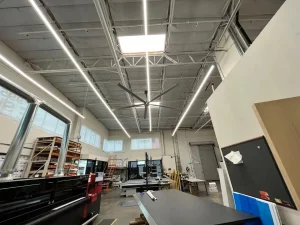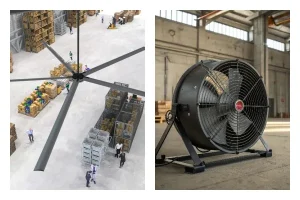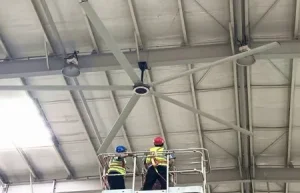Sweltering conditions and poor air circulation can degrade comfort and efficiency in large buildings—think massive warehouse, bustling gym, or cavernous sports center. Yet conventional ceiling fan units often fail to move air evenly across vast spaces. The remedy? Embrace HVLS fan systems, the low-speed wonders crafted to unify indoor climates.
Large ceiling fan systems designed for extensive coverage are called HVLS fans (High-Volume, Low-Speed). Unlike smaller residential fans, HVLS fans feature broad fan blade diameters—from 8 feet up to 24 feet—rotating at low speed but moving large amounts of air. By circulating airflow gently, they reduce hot spots, moderate temperatures, and often cut energy costs. Whether in a warehouse, sports center, or manufacturing plant, these big low-speed fan solutions provide wide, uniform coverage unattainable by typical ceiling fans or compact box units.

HVLS Fan in a Large Industrial Facility
To grasp the identity of “big ceiling fans,” start with HVLS fan fundamentals. HVLS stands for High-Volume, Low-Speed—a specialized concept focusing on moving tremendous volumes of air with minimal rotations per minute. This contrasts with smaller “high-speed” fans that spin rapidly yet lack broad coverage.
HVLS fans revolve at low speed—often under 100 RPM—yet they shift a large volume of air. By harnessing wide fan blade diameters (sometimes 8 to 24 feet!), they effectively circulate air from overhead to occupant level. This synergy provides uniform cooling minus harsh gusts.
Key Distinction: While typical “residential fan” models revolve quickly in a smaller radius, HVLS solutions revolve slowly but sweep expansive footprints—perfect for gyms, warehouse spaces, or commercial and industrial sites.
A warehouse is vast, with tall ceilings and open aisles. Stale pockets can form near stored products or corners. HVLS fans tackle these challenges via broad overhead coverage. As the low-speed fan rotates, it pulls air from above, dispersing it across the floor in a gentle wave.
HVLS fans vs. standard small fans? The HVLS approach merges minimal noise, broad coverage, and moderate power usage. This synergy is especially beneficial in a warehouse where standard “box fans” or small overhead units can’t unify the entire environment effectively.
Case: A logistics firm replaced multiple box fans with two 18-foot HVLS solutions, drastically improving occupant comfort while lowering total energy consumption by nearly 20%.
A typical ceiling fan found at home or small offices has a relatively short diameter (often 42–60 inches) and spins at moderate to high speeds. It can cool a living room or a personal workspace just fine. However, that’s limited coverage. In large settings, you’d need many such fans, each possibly adding to your energy overhead.
A specialized hvls ceiling fan boasts a large diameter (8 to 24 feet) rotating at low speed. Because the fan covers bigger footprints per rotation, it can unify entire sections of a warehouse or gym with consistent airflow. This technology thrives in areas with high ceilings—industrial ceiling fans measure large diameters for stable, gentle breezes.
In short: The difference between a typical ceiling fan and an HVLS model is scale and coverage. For a small office, a standard home unit might suffice, but for a large space—like a distribution center or sports venue—an HVLS approach fosters comfort with minimal fuss.
residential fan units are built to handle rooms up to maybe 400–500 sq. ft. If your environment is a typical living room or modest office, that might be enough. But if you manage a warehouse or industrial area, the coverage is far too limited.
A low-speed HVLS solution is the champion of broad coverage. Because these fans revolve gently but push a high volume of air, they unify climates in large footprints. In contrast, multiple small fans might lead to swirling eddies or pockets of cold vs. warm air. The HVLS approach ensures occupant comfort without overuse of AC or numerous fans on the floor.
Conclusion: If your building surpasses 1,000 sq. ft.—and particularly if it’s 5,000 sq. ft. or more—HVLS fans can yield better occupant comfort with fewer total fans.
fans vs HVLS is an ongoing conversation among facility managers. The fundamental contrast is:
Takeaway: If you need cost-effective coverage for a huge area—hvls fan solutions are typically more energy efficient and occupant-friendly than multiple small fans.

Fans vs. HVLS Fans
High-volume low-speed fans revolve on the principle that bigger diameter, slower rotation, and specialized blade design can push massive airflow across thousands of square feet.
By rotating large blades at low speed, HVLS solutions produce a gentle but far-reaching breeze. This fosters stable temperatures in industrial settings, warehouse floors, or gymnasiums. The method stands in stark contrast to “high-speed fans,” which revolve quickly but only push air in a limited zone.
Spinning slower means the fan demands less torque from the motor, so you benefit from less friction, less noise, and minimal mechanical strain. Because the fan sweeps a wide arc, it still move air effectively. This synergy yields an extremely energy efficient approach to occupant comfort, frequently letting you dial back the AC or heating, boosting cost savings.
While big overhead fans are commonly associated with a “cooling effect,” HVLS fans also help with warmth distribution. In winter, warm air often lingers near the ceiling. Running a hvls fan at a slow pace can push that warmth downward, stabilizing occupant-level temperatures and reducing your heating load.
When a building’s heater is on, hot air rises to the ceiling. HVLS units revolve gently, “de-stratifying” or mixing these layers to keep the floor zone warm. Occupants feel less need to crank the thermostat, saving energy usage.
In hot months, HVLS fans create breezes that accelerate sweat evaporation, letting people feel cooler without intense AC usage. By harnessing stable airflow, the environment remains fresh, especially in large commercial or industrial halls.
Blade diameter is the heart of HVLS. A small “box fan” might measure 1–2 feet across, while an HVLS unit can be 8–24 feet in diameter. Because each rotation displaces an enormous air column, the fan can run at low speed—often under 100 RPM—and still produce robust coverage.
Fans are designed to move air by the shape and span of their blades. HVLS solutions have advanced airfoils or contoured edges that effectively scoop or “push” air downward, generating a consistent, gentle breeze. The synergy of broad diameter plus minimal velocity fosters balanced occupant comfort without creating wind tunnels.
Conclusion: The “fan blade size matters,” phrase is especially relevant for HVLS. Larger diameters equate to broader coverage at lower speeds, ensuring occupant well-being in big footprints without the intense blasts typical of smaller, high-speed fans.
HVLS fans often appear in massive warehouse or industrial buildings. Yet they also can serve well in big barns, gyms, shopping centers, or even large covered patios. Some outdoor ceiling fan models incorporate HVLS design principles, enabling calm, wide-reaching breezes in covered open-air settings.
Mount them where overhead structure is strong enough. Because HVLS units weigh more than typical fans, a solid anchoring point is essential.
Case: A country club with a large covered patio installed a 14-foot HVLS overhead, drastically improving occupant comfort during scorching afternoons. The gentle breezes boosted business, with patrons lingering longer.
Selecting the right fan for your space means analyzing ceiling height, total square footage, occupant needs, and your existing climate approach. If you have a standard building up to 5,000 sq. ft., an 8–14 ft. HVLS might suffice. Meanwhile, a warehouse or distribution center above 15,000 sq. ft. might adopt multiple or single 20+ ft fans.
Fan speed also influences coverage. HVLS solutions revolve gently, so minimal noise or turbulence arises. With a smaller diameter or “smaller fans,” you might cover the same area but at higher total energy usage or more complicated placement.
Look: Many building managers also rely on specialized help from HVLS manufacturers or local installers. The final result? A stable, overhead solution that fosters year-round occupant comfort.

Install a HVLS Fan
How large can a big ceiling fan (HVLS) get?
An HVLS fan typically ranges from 8 to 24 feet in diameter. These big ceiling fans revolve at a low speed but move air effectively, covering tens of thousands of square feet.
Do HVLS fans only belong in a warehouse?
While HVLS fans thrive in warehouse or industrial settings, they also suit large commercial or sports complexes. Some specialized “outdoor ceiling fan” HVLS solutions handle partially open or covered patios, providing broad, gentle breezes.
What’s the advantage of a low-speed fan approach?
Low-speed fans use wide-diameter blades, pushing large volume of air with fewer rotations. This yields minimal noise, uniform coverage, and can reduce reliance on conventional AC, saving energy consumption costs.
How do HVLS fans compare to smaller fans in energy efficiency?
One HVLS unit can replace multiple smaller fans, thus often lowering total power draw. Because it runs at a low speed with a wide fan blade, the synergy fosters effective coverage per unit energy, making HVLS solutions typically more energy efficient.
Are HVLS fans appropriate for open-air or semi-outdoor setups?
Yes, certain HVLS fans are rated for partial open-air use—like large patios or pavilions. They require robust brackets and weather-resistant features, but can unify air in expansive, covered outdoor areas.
What are big ceiling fans called? They’re generally recognized as HVLS fans—High-Volume, Low-Speed solutions that revolve gently yet move a broad swath of air. Contrasted with a typical “residential fan” used in smaller rooms, HVLS solutions can measure 8–24 feet in diameter, built to unify climates in massive footprints like a warehouse or sports center. By providing energy efficiency at scale, HVLS fosters occupant comfort, consistent airflow, and often cuts energy consumption.
At our hvls fans Manufacturing operation, we strive to design big ceiling fans that are not just robust in coverage but also user-friendly in maintenance. If you’re seeking an industrial or commercial approach to climate control, an HVLS fan may well be the “fan for your space.” Our advanced engineering ensures minimal noise, gentle breezes, and synergy with hvac systems, so you can keep employees, visitors, or students comfortable year-round.
Fans come in all shapes and speeds, but for truly large coverage, an HVLS approach typically wins out. From ensuring occupant well-being in a bustling warehouse to fueling productivity in a big open gym, these big ceiling fans blend modern technology with proven airflow principles. If you’re ready to adopt or explore HVLS further, we at hvls fans Manufacturing stand prepared to guide your selection, ceiling fan sizing, and final fan installation.
If you’re keen on discovering how a low-speed approach can transform your large facility, please reach out to our experts at hvls fans Manufacturing for guidance. Let’s harness the power of HVLS technology—high-volume low-speed—to keep your environment stable, comfortable, and cost-effective!

Hi, I’m Michael Danielsson, CEO of Vindus Fans, with over 15 years of experience in the engineering and design industry. I’m here to share what I’ve learned. If you have any questions, feel free to contact me at any time. Let’s grow together!